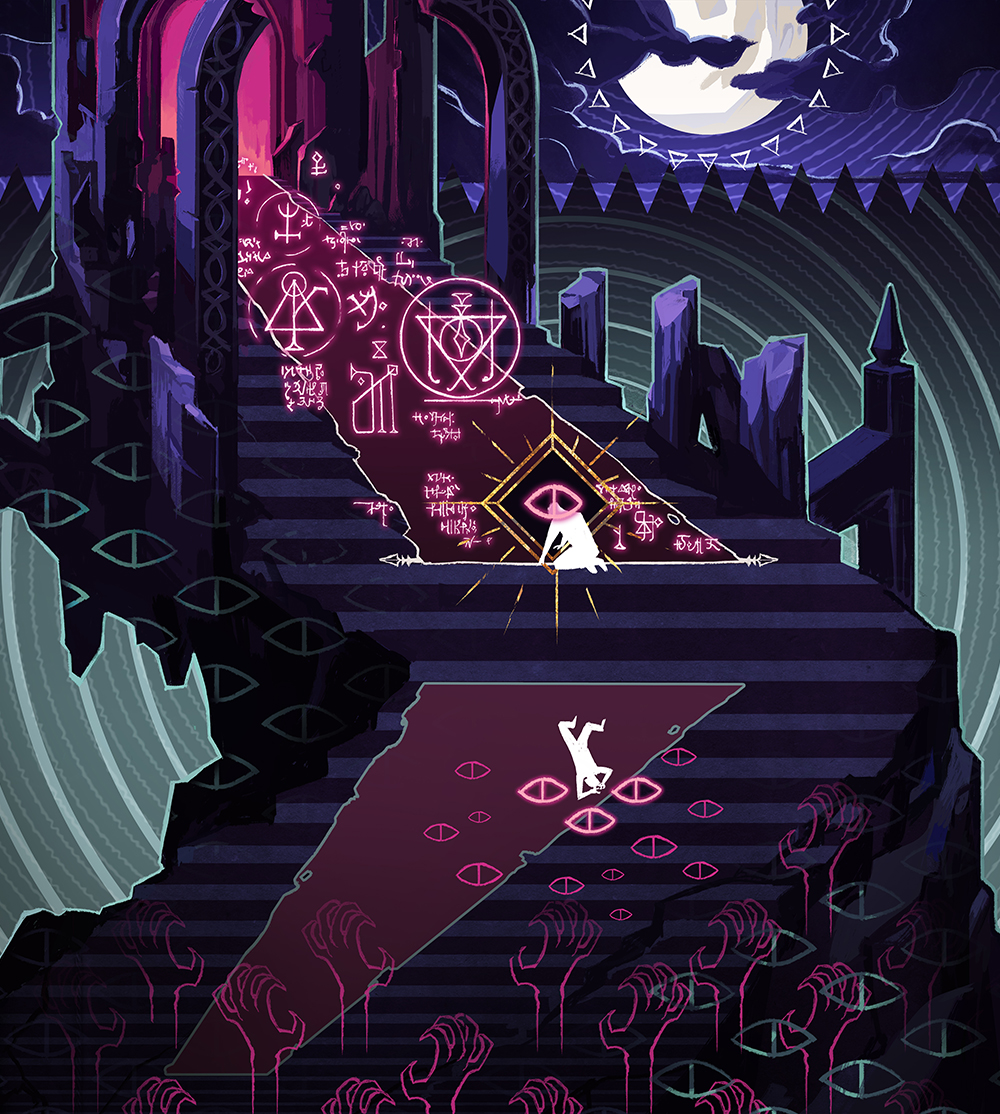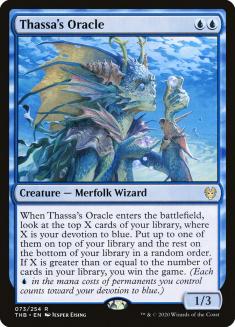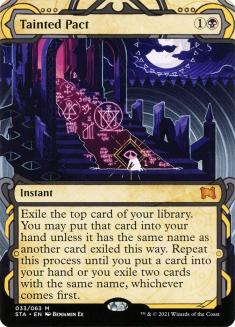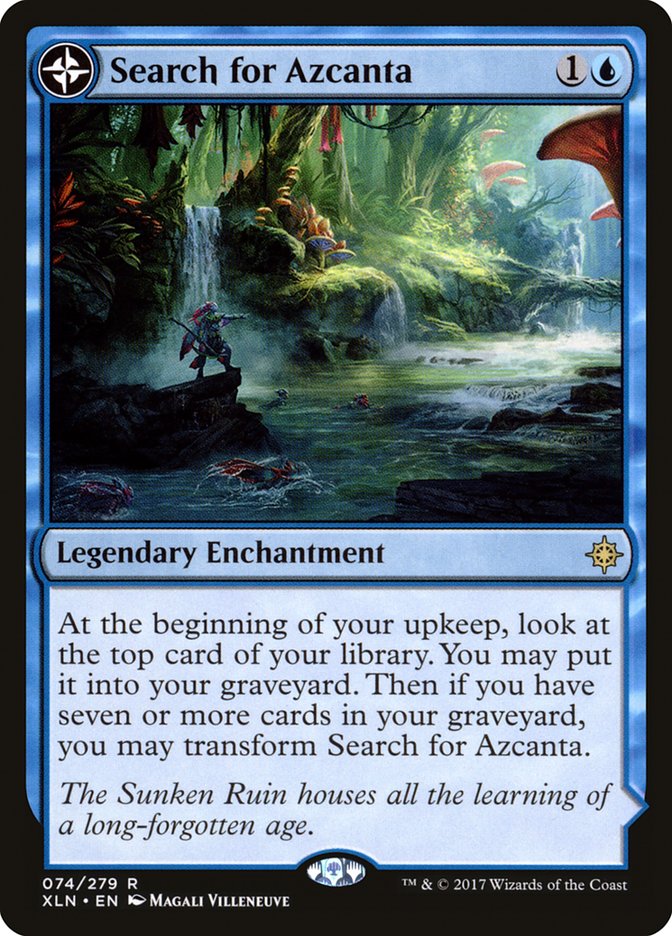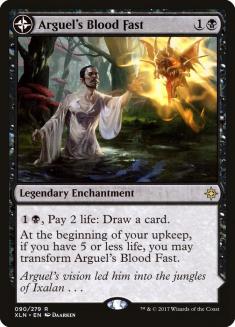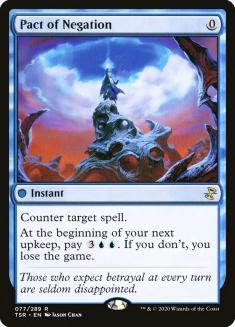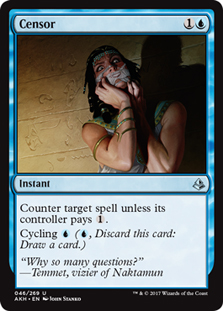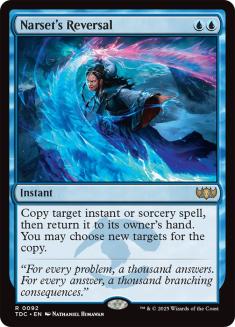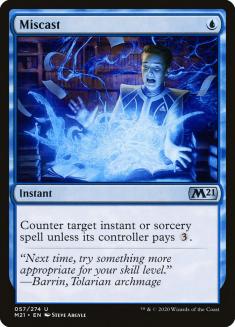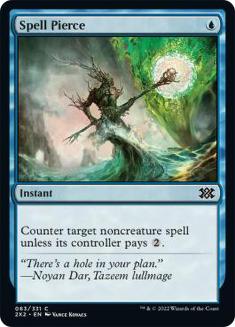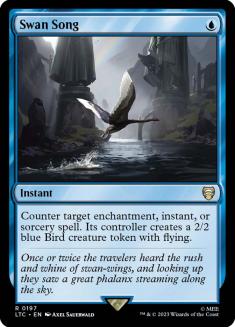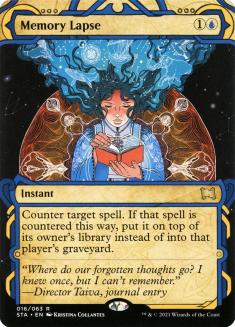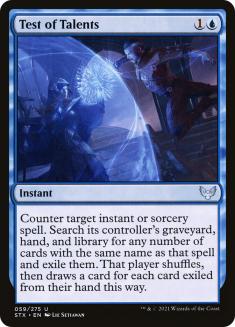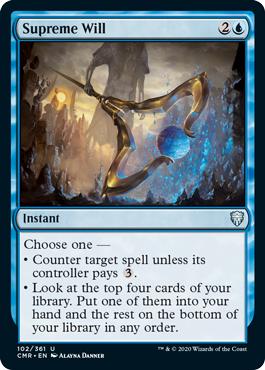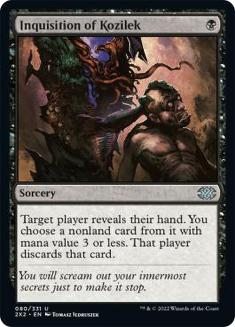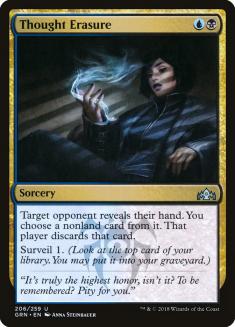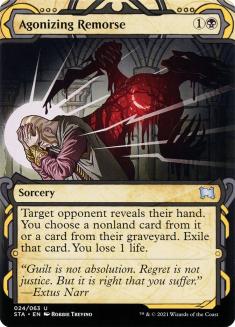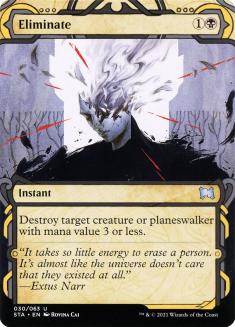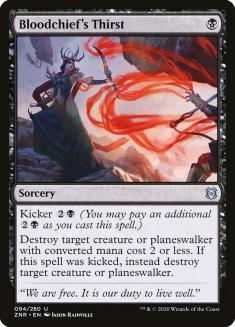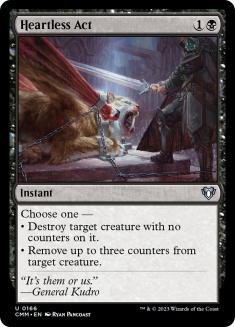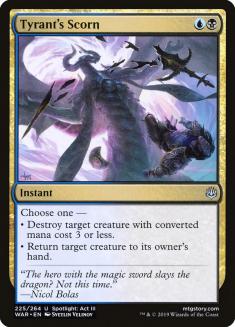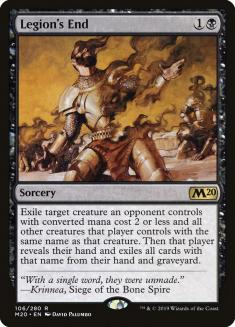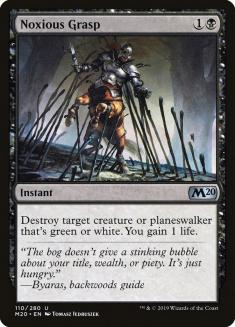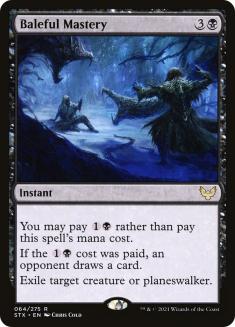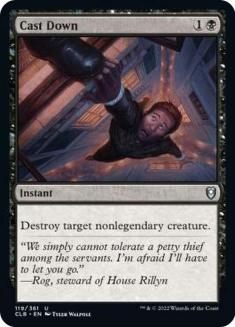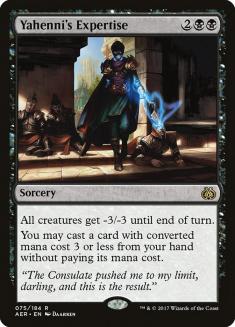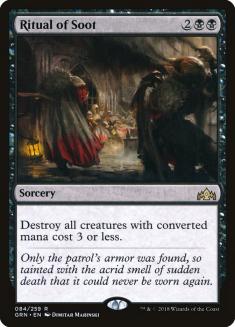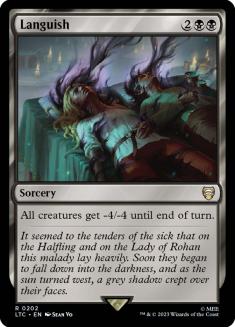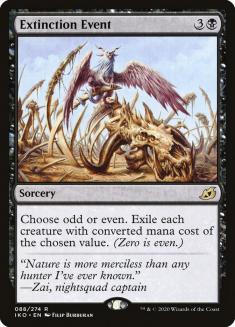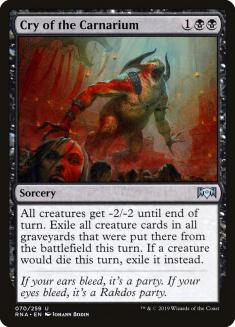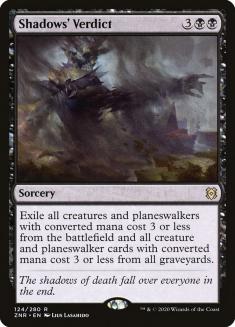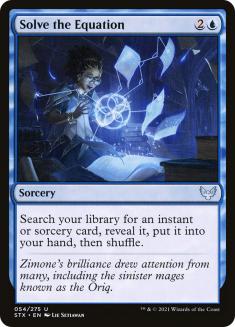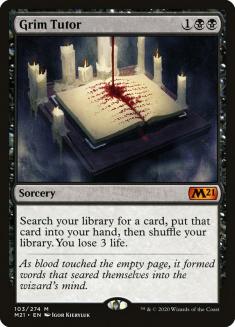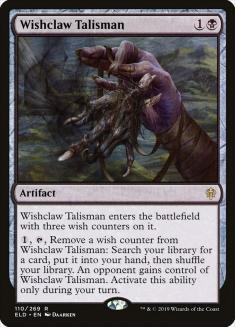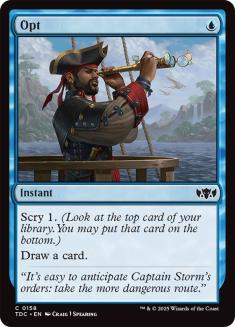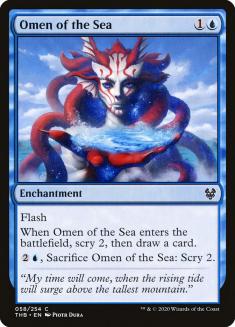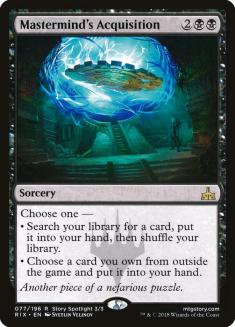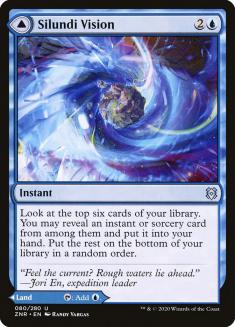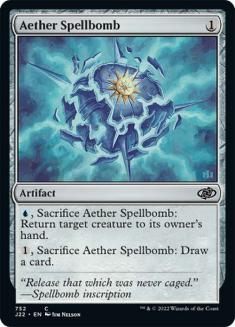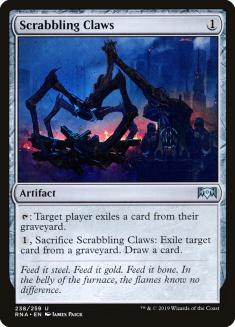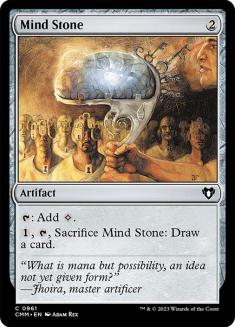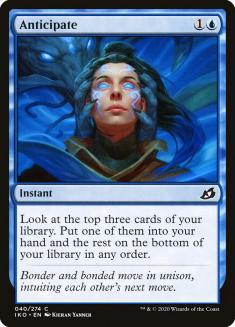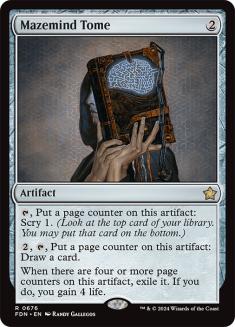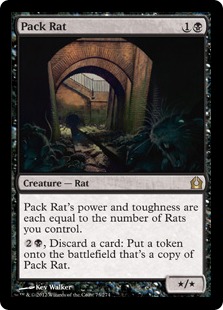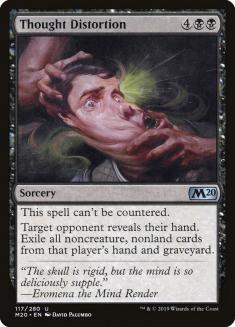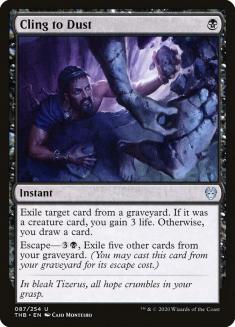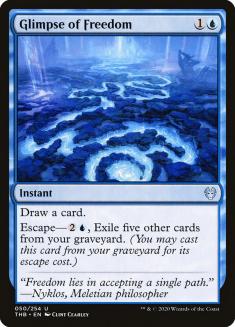Dimir Tainted Pact (Lurrus) is, in my opinion, the best deck in Historic. Despite several client limitations (which may or may not continue to exist — we’ll talk about those a bit later), about 50% of Rivals/MPL players used it in the May Strixhaven League Weekend, which is a pretty absurd number, and all versions of the deck had positive winrates even when everyone knew it was going to be the most popular deck. Right now, I believe you either need to play this deck or a deck tuned towards beating it, but given that I don’t think there is any deck that beats it and holds its own against an open field, I believe your best bet is just playing the broken deck while you still can.
Before we start, I’ll post the decklist so you know what I am talking about (explanations will come later):
Creatures (4)
Lands (24)
- 1 Swamp
- 1 Lonely Sandbar
- 1 Barren Moor
- 1 Snow-Covered Island
- 1 Snow-Covered Swamp
- 1 Watery Grave
- 1 Hallowed Fountain
- 1 Drowned Catacomb
- 1 Bojuka Bog
- 1 Temple of Deceit
- 1 Fetid Pools
- 1 Ifnir Deadlands
- 1 Castle Vantress
- 1 Castle Locthwain
- 1 Fabled Passage
- 1 Zagoth Triome
- 1 Clearwater Pathway
- 1 Brightclimb Pathway
- 1 Riverglide Pathway
- 1 Barkchannel Pathway
- 1 Blightstep Pathway
- 1 Darkbore Pathway
- 1 Hengegate Pathway
- 1 Ice Tunnel
Spells (33)
- 1 Brainstorm
- 1 Duress
- 1 Island
- 1 Grim Tutor
- 1 Scrabbling Claws
- 1 Aether Spellbomb
- 1 Mind Stone
- 1 Opt
- 2 Tainted Pact
- 1 Pact of Negation
- 1 Thoughtseize
- 1 Negate
- 1 Inquisition of Kozilek
- 1 Anticipate
- 1 Yahenni's Expertise
- 1 Fatal Push
- 1 Censor
- 1 Search for Azcanta
- 1 Mastermind's Acquisition
- 1 Thought Erasure
- 1 Expansion
- 1 Ritual of Soot
- 1 Narset's Reversal
- 1 Mystical Dispute
- 1 Wishclaw Talisman
- 1 Omen of the Sea
- 1 Cling to Dust
- 1 Eliminate
- 1 Silundi Vision
- 1 Agadeem's Awakening
- 1 Solve the Equation
- 1 Baleful Mastery

For those who don’t know, the combo consists of casting Tainted Pact and declining on every card until your library is empty, and then casting Thassa’s Oracle to win the game. Tainted Pact stops once you hit a duplicate, which is why the deck needs to be all one-ofs, including lands. (Pact and Oracle themselves can be two-ofs, since you need one of each in hand to win the game anyway, so you know you’re not going to hit a duplicate in your deck by the time you cast Tainted Pact.)
This deck is a very good deck for two main reasons. The first is that it’s just faster than the rest of the format. If someone cannot interact with you, it’s very unlikely they can race you; you do a good job of either finding the combo on Turn 4 or delaying them for a while and finding the combo on Turn 5 or 6. Decks like Izzet Phoenix, Jund Company, Jund Food, Mono-Red Goblins, Gruul Aggro, and Bant Midrange tend to be easy prey. The insta-kill aspect of the deck actually comes up a fair bit — sometimes a control deck will establish control of the game and then end up losing to Cauldron Familiar recursion or a topdecked Muxus, Goblin Grandee, for example, but with this deck, when you win you win and that’s valuable.
The second reason is that, even if your opponent is disrupting you, you’re pretty resilient. The deck has several counterspells and discard spells, spot removal, sweepers, and an extra free card with Lurrus of the Dream-Den. You’re capable of grinding out a lot of disruption spells and you end up winning long games as well as short ones.
Is every matchup good for Dimir Tainted Pact? No, I think some matchups are not good like Dimir Rogues and Mono-Black Death’s Shadow. However, these decks are quite bad overall, and also very beatable. When your bad matchups are 55% versus you and 40% versus the rest of the field, they’re unlikely to be played, and in this case your good matchups tend to be quite good to make up for it. If your bad matchup is 45% and your good matchup 65%, that’s an easy trade to make.
Surely Having to Play So Many One-Ofs Is a Big Limitation?
Well, yes and no. The key here is that the card pool in Historic is deep enough that you can find second- and third-best versions of basically every spell you’d want to play. Yes, maybe Fatal Push is the better removal spell and you’d rather play three Fatal Pushes, but you’re not losing much by playing one Fatal Push, one Eliminate, and one Tyrant’s Scorn instead. Sometimes the cost is a bit bigger — of course you’d rather play four Brainstorms than one Brainstorm, one Opt, and one Anticipate — but when all is said and done, I think this is a very reasonable cost to pay to be able to have this kill mechanism.
The effects of the “commander rule” are most prominent in the manabase. You’d really like to have better mana, but only being allowed one of each multicolored land means you’re going to play Ice Tunnel and you’ll be happy about it. Several lands enter the battlefield tapped, several lands only add one color, and several lands damage you (the deck is even playing off-color shocklands). Still, I believe this is worth the cost.
The Magic Arena Limitations
When we played the May Strixhaven League Weekend last weekend, there were two big limitations for Tainted Pact decks. The first was that, due to a bug with devotion, flip cards that were lands in one side and permanents on the other were banned. This meant you couldn’t play Search for Azcanta or Arguel’s Blood Fast. Wizards of the Coast (WotC) will fix this soon and you should not have to worry about it. I’ve included both these cards in my list (Search for Azcanta in the maindeck and Arguel’s Blood Fast in the sideboard versus slower decks).
The second limitation is the fact that Tainted Pact just takes way too long to resolve. Due to Arena animations, it’s literally impossible to resolve a Tainted Pact without a timeout (at least I’ve never been able to do it and I’ve never heard of someone who could do it). Most of the time one timeout is enough, but if you had to think for a while during your turn it might also not be.
This is a major problem, and because of this issue, the deck cannot kill naturally on Turn 3. Normally, a hand of two lands, Tainted Pact, and Thassa’s Oracle is a Turn 3 kill — you cast a Tainted Pact at the end of Turn 2, mill your deck down to the last card, draw said card, and then cast Oracle and win. However, if you try to do that on Magic Arena right now, you will time out and get decked on Turn 2 (you can’t keep one remaining card to be able to get another turn to win the game). This means that, unless you have a mana accelerant (such as Mind Stone), the earliest you can kill is Turn 4.
There are also spots in which this can hurt you even if it’s not preventing an early kill. Sometimes you don’t have a timeout even later in the game (you gain a timeout each time you spend three turns without roping, as far as I am aware), and sometimes you start casting the Pact after too much time has already passed. For example, during the League Weekend, I lost a game because I didn’t think I would have enough time to cast Pact and deck myself, which meant I had to start with the Oracle, and that turned out to be the losing line.
Even with these artificial limitations, the deck was still half the field! I don’t know whether this animation issue will be fixed or not, but if it is fixed, this deck will become even more powerful than it already is. But make no mistake, it’s still plenty powerful right now.
Playing the Deck
One thing that you should know about this deck is that it’s very hard to play. Not only are the timeouts a nightmare (it can be hard to concentrate when the threat of just ending your turn is constantly looming, and if you misclick on Pact, you’re dead), but it’s also a deck with multiple win conditions, card drawing, and tutors that offers myriad possibilities every turn — knowing if you should try to assemble the combo or try to control the game (e.g. should you cast Opt or Inquisition of Kozilek on Turn 1? Eliminate or Wishclaw Talisman on Turn 2? Solve the Equation or grab Lurrus Turn 3?) is very hard and something that will only come with a lot of experience.
An inexperienced Dimir Tainted Pact player will still win a lot of games by just assembling the winning combination, but they will also lose a lot of games that they could have won. This will happen even to people who are very experienced with the deck, because since it’s all one-ofs it’s hard to find yourself in the same situation multiple times (or even a similar situation).
If you play ten games of Izzet Phoenix versus Jeskai Control, this will give you a good idea of how the matchup goes; if you play ten games of Dimir Tainted Pact versus Jeskai Control, each game will be totally different from the next and in the end you might still have no clue what’s actually going on in the match. I will try to give you the best tips I have for each matchup and the most common lines, but honestly it will be a poor substitute to actually experiencing the games for yourself.
One area you can probably internalize is the different kills the deck has access to. Not all of them are obvious, and you might miss them if you aren’t specifically looking for them, but here are the most common:
Thassa’s Oracle + Tainted Pact + Four Mana
This is the “standard kill” that you’re trying to assemble every game. If you have these two cards in your opening hand, you can win the game with four mana. The most common way of doing this is enabling Full Control, casting Thassa’s Oracle, and then, with the ability on the stack, casting Tainted Pact. This is for a couple of reasons:
- If you time out during the resolution of Tainted Pact, you will win the game. The default is to mill every single card, which means Oracle will resolve and kill them. If you haven’t cast Oracle, though, you will mill your entire deck and pass the turn.
- If your opponent is going to counter something, you’d usually rather they counter the Pact, because otherwise you die. You can win a game where Pact is countered, but you cannot win a game where Oracle is countered and you have zero cards in your library.
- Thassa’s Oracle is vulnerable to Mystical Dispute, so if you cast Oracle first they have to counter it. They might stop your combo for that turn but you still basically traded one-for-one with their Dispute rather than losing the game.
There are exceptions to this, though. Sometimes you’d rather they counter the Oracle, so you lead with Pact. This can be the case if you have a second Oracle in your hand or a Lurrus. Sometimes you’re afraid of Negate or Miscast, so you cast Pact first. Then, if it resolves, you can cast Oracle. Here you basically have to identify what you believe is the most common way you lose the game and try to play around that, but the default is Oracle first due to timing out issues.
Tainted Pact + Tainted Pact + Six Mana (Or 2 + 4 in Two Different Turns)
If you have two Tainted Pacts, the combo also works. You cast the first Tainted Pact for Oracle and the second to deck yourself. Here you usually need one timeout to find Oracle, but if you’re desperate you can just cast Pact and hope to find it before your turn ends.
Tainted Pact + Expansion // Explosion + Six Mana (Or 4 + 2 in Two Different Turns)
Expansion // Explosion is a very versatile card in the deck. It can fight a counter war (just copy their counter), double-up as a removal or dig spell (copy your own spell), or act as a combo piece. If you have Tainted Pact + Expansion, you can just copy the Pact and it will accomplish the same as having two Pacts; the copy will find Oracle and the Pact itself will deck you. You do need a timeout for this, even if you do it on your turn with six mana, since there’s no window for you to cast the Oracle between the two Tainted Pact copies (they will both resolve at once, basically).
Tainted Pact + Narset’s Reversal + Eight Mana (Or 4 + 4 in Two Different Turns)
Narset’s Reversal is similar to Expansion // Explosion in that it plays the role of counterspell in a counter-war and also a combo piece. It’s even better than Expansion in a counter-war, since you get your original spell back. For example, if you cast Thoughtseize and they Negate it, you can cast Narset’s Reversal on your own Thoughtseize, and the end result is that you get a copy of Thoughtseize that’s resolving and the original Thoughtseize back in your hand. It also works against uncounterable cards such as Thought Distortion and Dovin’s Veto, so I’m surprised that not everyone had this card in their deck (I think it’s quite good).
As for the combo itself, you cast Tainted Pact and then Narset’s Reversal it. The copy of Pact finds Oracle and this leaves you with Oracle and Pact back in your hand. This usually happens at the end of the turn since it costs an extra four mana, though, so it’s a Turn 4 play to set up a Turn 5 kill.
Tainted Pact + Thassa’s Oracle at the Bottom of Your Library
This is the “sneaky kill” that actually comes up a lot and you will miss every time if you’re not paying attention. If you know where in your deck a copy of Thassa’s Oracle is, it’s safe to go deep enough until you’re one card from it, and then take that card. This results in drawing the Thassa’s Oracle as your next card and being able to win the game if that was indeed the last card in your deck. This works if you have another way to draw a card (such as an Aether Spellbomb or Mind Stone) but also if you’re just casting the Tainted Pact at the end of your opponent’s turn or during your upkeep (so you draw the Oracle).
In this deck, there are a lot of ways to put Oracle on the bottom of your deck. You can do it during mulligans, you can scry with Temple of Deceit or Opt, or you can hit it with Anticipate or Augur of Bolas. Some cards will not let you order the cards that are headed to the bottom of your deck (such as Silundi Vision), but the ones I mentioned will. This means that a lot of the time that you actually find Oracle with these cards you don’t need to take it, and it’s like drawing a free card. People complain that Augur of Bolas doesn’t find Thassa’s Oracle, but in reality it kind of does by simply putting it on the bottom of your deck.
Past that, you can also win the game with Lurrus beatdowns, Mastermind’s Acquisition for Pack Rat, a hardcast Thassa’s Oracle when the game goes very long or even a hardcast Expansion // Explosion.
The Decklist
The first thing you have to decide is whether you want to play two or three colors. Personally, I always thought that two colors was best — the mana is not even great with two colors, so adding a third is weird to me. I’ve heard that you’re priced into playing some multicolored lands anyway (e.g. Steam Vents / Blood Crypt), but even if that’s true, you still have more random cards you can’t cast and more lands that will enter the battlefield tapped, not to mention that it’s a real cost if you need to play a Pathway on red or Fabled Passage for a Mountain.
Besides that, there weren’t any red cards I even wanted to play. Some people splashed for Nicol Bolas, the Ravager and I always felt like even if that card cost four colorless mana and didn’t clash with Lurrus, I would still not want it; it’s just not what the deck is trying to do.
Now, I saw some versions at the League Weekend that played red for exclusively Underworld Breach. I think that card is actually quite good in mirrors and slow matchups, so that’s something I can maybe get behind. For the moment, I’m happy not having it but I need to test the card more and report back. Past that, though, I’m confident you don’t want a third color.
Now, the individual cards:
A lot of the cards in the deck are self-explanatory, but the last few slots are really not. Given that it’s a singleton deck, people tend to have a lot more “freedom” when it comes to adding the last ten or so cards, which means that, for a deck that’s as powerful and as widely played as this is, there’s a surprising lack of agreement on what the best version actually is, and you can get a big edge by just playing the best cards that other people are not playing (e.g. Narset’s Reversal).
I think the best way to do this is separating the cards into “must-play” and “maybes.” A must-play card is one I believe should be in your deck no matter what. A maybe is a card that you might play because you expect a certain metagame. As an example, I believe you must play one sweeper, and the best sweeper is Yahenni’s Expertise, but if you expect more creature decks, you can play up to three sweepers.
The Counterspells
Must-Play:
Maybes:
We expected a heavy blue field in the MPL, so we opted to have the two copy spells that act as counterspells as well as an extra Memory Lapse. In the sideboard, we had Swan Song and Test of Talents. Personally, I think Miscast and Spell Pierce are just okay. They’re much better in Game 1s than Game 2s, since the sideboarded games go much longer, which makes them dead more often. If you want to play them, I would play them in the maindeck, not in the sideboard.
Supreme Will is sort of a special case, since it’s not really a counterspell. It’s more like a digging spell with a second mode. I don’t hate it, but there’s a lot to do with three mana already so we opted to not play it.
The Discard Spells
Must-Play:
Maybes:
Again, this was a reflection of the field we expected; we opted to play four of those in the maindeck. Against Dovin’s Veto, discard is better than counterspells, so you could even play a fifth somewhere (perhaps over the sideboarded Test of Talents).
The Spot Removal
Must-Play:
Maybes:
Here we played the minimum for the same reasons. In an open field, I would consider moving the Tyrant’s Scorn to the maindeck (I think it’s the best of the remaining removal spells). Everything else is in the sideboard for us.
The one big exception is Baleful Mastery, and the reason we played it was that it was also a “combo breaker” in the mirror. If your opponent leaves zero cards in their deck, you can cast Baleful Mastery for two mana and kill them. If they leave one or two cards, you can cast it for four mana and remove the Oracle, so they won’t be able to kill you.
In Game 1, people usually have to run into it for two mana because otherwise they risk losing to any single removal spell (such as Fatal Push). In sideboard games, they should be able to play around it. It’s important to note that having another blue permanent will stop this from working (they can just keep one card), so if they have Omen of the Sea, Augur of Bolas, or Search for Azcanta (transformed or otherwise, because of the bug), you need to watch out.
The Sweepers
Must-Play:
Maybes:
Given that we had so few spot removal spells, we felt we should maybe have a second sweeper to shore up against aggro decks (as well as Dimir Rogues which we expected a bit more of). In the end it was totally unnecessary given the metagame that existed, so if I could go back I would have played zero, but I think the correct number for ladder and open-tournament play is two.
The Card Drawing/Selection
Must-Play:
Maybes:
I don’t think you need to play the artifacts but I’m honestly a big fan because of how they work with Lurrus. They’re bad draw spells by themselves, no questions asked, but they have added utility and the Lurrus recursion really does come up, especially in sideboard games when there are almost no removal spells, so I really think they are worth it. I think Scrabbling Claws is better than Soul-Guide Lantern because you can target your own graveyard against Dimir Rogues.
Note here that I specifically excluded Fae of Wishes because I don’t think you should play it. The main issue is that it doesn’t really work — if you find Tainted Pact you still have two Pacts in your deck, so you need an extra two mana to go off, and if you find Jace, Wielder of Mysteries you still have two Oracles in your deck. This means it only works in very specific situations and is way too narrow for me.
Miscellaneous
I think Pack Rat is by far the most important sideboard card in your deck and is definitely a must-play. Most of the time you draw it in your opening hand you will win versus the mirror or a control deck, and sometimes it’s good even if you draw it Turn 15. It also does the job of being a win condition you can Mastermind’s Acquisition for in Game 1, which to me means you don’t need to play an extra Tainted Pact or a Jace, Wielder of Mysteries in the sideboard.
The Matchups
VS The Mirror
The mirror is the most important matchup at this point and I wish I had more to tell you than what I’m going to tell you, but it’s incredibly complex to play and players can win in a variety of ways, so basically all bets are off. Each game is completely different from the next and you have to figure it out on the fly.
When I played against Martin Juza in the mirror, he won Game 1 with Expansion // Explosion damage, I won Game 2 with Pack Rat, and he won Game 3 with the combo. When I played versus Brad Nelson, he beat me by casting two Oracles with four cards in his deck when I had dealt with all his Pacts. This is to say that there’s no one thing you need to do to win the matchup and you should always be on the lookout for how to actually win the game. That said, Game 1 usually ends by combo.
Out:
In:
After sideboarding things slow down a bit, because there’s some more disruption (though not a lot more in our case, as we already play most of the disruption in the maindeck). Lurrus becomes a much bigger plan, since there’s almost no removal in the deck anymore, which is part of why I like Ifnir Deadlands so much; it gives you an out to their Lurrus that doesn’t demand you leaving in a removal spell. Baleful Mastery is not bad as a removal spell either, since it can help break up the combo, so you could consider having that instead of something like Aether Spellbomb, but I think Lurrus lives often enough post-sideboard that it’s worth having all the sacrifice artifacts you can.
One note on Thought Distortion—- it’s not bad in this matchup, but it’s also quite dangerous. If they have the combo in hand, they can respond with Pact, mill themselves down to one card, and then untap and kill you with the Oracle. As such, it’s not safe to just tap six mana to cast Thought Distortion; you need to have some information about their hand first (or risk losing the game when you cast it).
VS Control
I think control decks are good matchups in general, though they can make your life hard if they want to. The versions with multiple maindeck Dovin’s Vetos and Gideon of the Trials are the most troublesome, but I still think you’re favored. Game 1 you almost always win with the combo.
Out:
In:
The sideboard here can change depending on what their deck is, but this is the baseline. You want Eliminate, Baleful Mastery, and Noxious Grasp to deal with the planeswalkers, but if they don’t have Gideons then you can trim more of those. The Jeskai decks that people are playing don’t have many counterable counterspells, so I don’t like Swan Song versus them, but it would be good versus a different control deck (such as Dimir Control). Lurrus is good versus them post-sideboard but not that reliable because they often leave in some removal spells, like Lightning Helix or Prismari Command.
As an aside, be careful with Prismari Command. They can force you to draw two cards which can kill you mid-combo.
VS Aggro
This is just a race, and one you usually win. The more aggressive they are the better of a chance they have, especially since your deck is not geared towards this matchup in Game 1, but I think you’re favored versus all sorts of aggro decks.
Out:
In:
After sideboard things tend to improve for you. You take out a lot of counterspells for removal and they usually don’t bring in much. White decks might have Gideon of the Trials, but you have Noxious Grasp, Shadows’ Verdict, Eliminate, Bloodchief’s Thirst, and Baleful Mastery, on top of some discard spells and a plethora of tutors, so it’s not hard to get rid of it. If they’re playing a deck where one of the removal spells is bad (such as Cry of the Carnarium or Noxious Grasp), you can keep in Search for Azcanta or Scrabbling Claws.
VS Dimir Rogues (Lurrus)
Your one bad matchup of the popular decks. You can stomach it because I think this deck is not very good in Historic as a whole. Still, they have everything one would want against you — pressure, discard, counterspells and the random win condition of milling your combo pieces — so they’re definitely favored (but not by as much as you’d think as their clock is often not very fast, especially if you remove the first Rogue). Cling to Dust is your best card against them, and you should consider playing Grim Tutor or Solve the Equation for it.
Out:
In:
Sideboarding versus Dimir Rogues is tricky because you want anti-creature cards but you also want anti-spells cards. My solution is just cutting the expensive tutors and hoping to draw your combo naturally in a longer game, but I don’t know if this is the best plan.
Glimpse of Freedom is only good versus Dimir Rogues, but it’s the best sideboard card versus them. Their deck as commonly built has a very slow clock if you can exile your own graveyard frequently, and adding another card that’s good to both draw and mill makes a big difference.
VS Izzet Phoenix
A very good matchup. Game 1 they usually just try to kill you and then die before succeeding.
Out:
In:
I’ve found that the best plan versus them is just to treat them as a deck you’re trying to goldfish against. The sideboard is not really well constructed for this matchup, as all your removal spells miss on something (Cast Down would be the one that hit all their creatures), but I think you’re mostly fine just trying to race their stuff. I like Tyrant’s Scorn more than Eliminate normally, but if they have Narset I think Eliminate is better.
So, in the end, do I think this deck will end up banned? My honest answer is yes. I think it’s too good and I also think it doesn’t really work with the software right now. If they fix the software problem, then the deck will become even more powerful, and then will really need to be banned. But WotC is notoriously slow to take action, so I think they might adopt a “wait and see” approach, and, if they do that, I recommend you play this deck for as long as you can.

